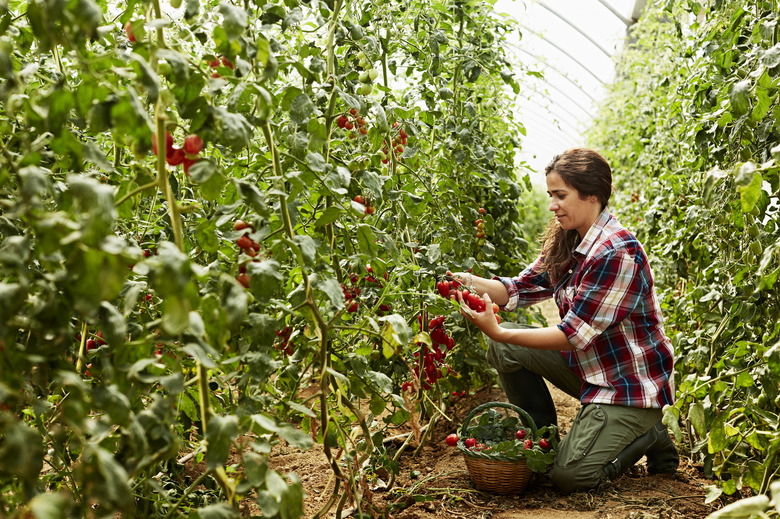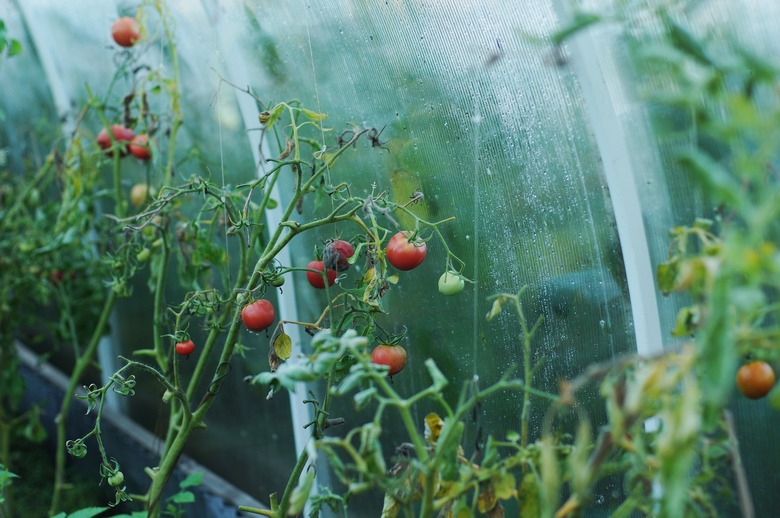How To Grow Tomatoes In A Hothouse
Tomatoes are the queen of the summer veggie garden, but can they also preside over the winter garden or fall or spring?
That depends on where you live and how much sunshine your area gets in each season. Tomatoes like it hot, but they can't grow on heat alone; they must have sunshine.
Tip
A hothouse is just a greenhouse that has supplemental heat rather than being heated by sunshine alone.
Should You Grow Hothouse Tomatoes?
While growing tomatoes in a heated greenhouse, i.e. a "hothouse," sounds like a no-brainer if you have one, several factors come into play that you need to be aware of. Some issues are:
- A greenhouse can harbor diseases and pests that can be tough to eradicate, once established.
- Plants in a greenhouse must be hand-pollinated to set fruit, since no natural pollinators are present inside the greenhouse, regardless of the time of year.
- If you are trying to extend the growing season to get a crop in the fall, winter or spring, your area may not have enough light, so you may need to add supplemental lighting.
- A hothouse can develop humidity, which can lead to fungal diseases.
- Summer in most of the country is too hot for plants to thrive inside a closed environment like a greenhouse.
- You will likely need special varieties developed specifically for greenhouse production.
A greenhouse, whether warmed to become a hothouse or not, receives about 20 percent less sunlight than outdoors. If you live in a northern climate, consider this when deciding how to use your hothouse.
For example, use it primarily as a season extender, starting seeds in the early spring in a hothouse, so you can set larger, more mature plants out in the garden as soon as your area warms up.
Alternatively, you can try to grow tomatoes in a hothouse for an off-season crop, but this is a trial-by-error procedure for a home gardener, so get ready for an adventure!
Starting Tomatoes in a Hothouse
You might be able to grow tomatoes year-round. If you live in a southern state, it's possible to plant in summer and harvest in the fall through winter and the following spring.
For northern climates with less sunshine, experts recommend the traditional cycle of planting in winter and harvesting in spring through the following fall. Here are the basics to start Tomatoes in a Hothouse:
1: Achieve Optimum Temperature
Prepare your hothouse with supplemental heat to achieve an optimum daytime temp of 70-82°F, with a night temperature of 62-64°F. Use a thermometer to be sure temps don't dip down too much in the colder weather.
2: Choose Grow Lights
Consider your source of supplemental light if you are trying to achieve fruit during winter and late fall when days are short. This likely entails LED growing lights, but multiple types of lights are available. So do some homework to see what will work for your particular size greenhouse.
3: Gather Supplies
Gather your supplies, including pots, sterile seed mix, amendments and growing stakes.
4: Choose Disease Resistant Tomato Variety
Choose a tomato variety specifically suited to greenhouse growing. These varieties are typically bred to be resistant to fungal diseases, which can be a particular problem in greenhouses.
5: Plant 3-4 Seeds in a Sterile Potting Mix
Plant three to four seeds in a sterile potting mix in small pots. When seedlings reach 4 to 6 inches tall, thin them to one plant per pot; then continue to transplant them into larger pots over the growing season.
Caring for Tomatoes in a Hothouse
- Fertilize regularly with a balanced fertilizer equivalent to 10-10-10, as per product instructions.
- Stake your plants to ensure they don't fall over.
- When the plants flower, hand-pollinate every other day using an electric pollinator, which is available from many nursery supply shops. This vibrates the flower clusters to spread pollen from the male to female flowers.
- Monitor your plants for disease and pests and take quick action if you find any.
- For seeds planted in summer, expect your first harvest around late October or November. For seeds started in November, you should get a harvest around March. And, for seeds started in late winter or early spring, expect a harvest starting in late spring or early summer.

